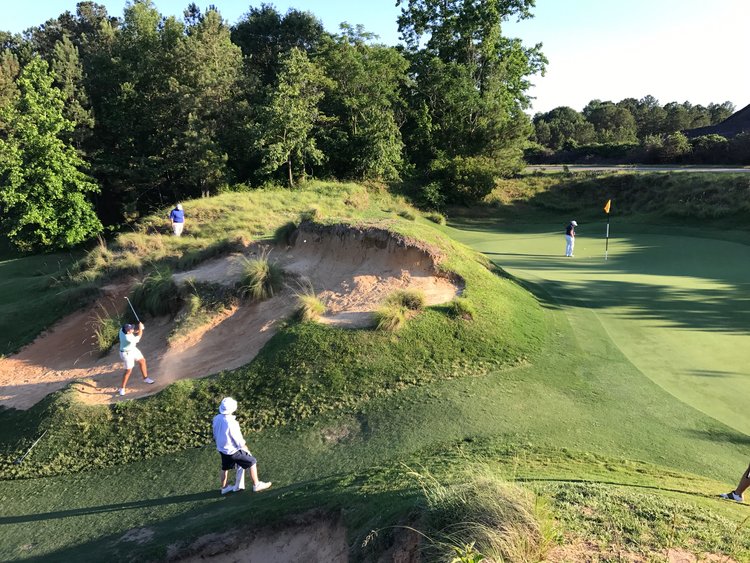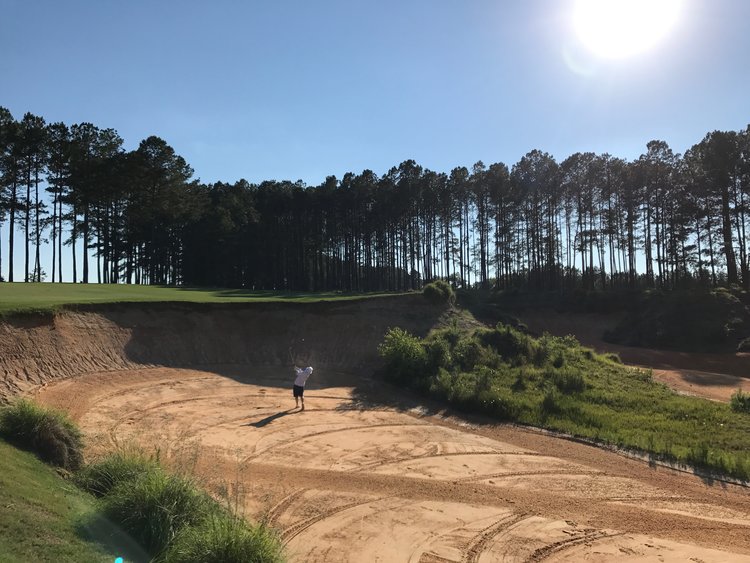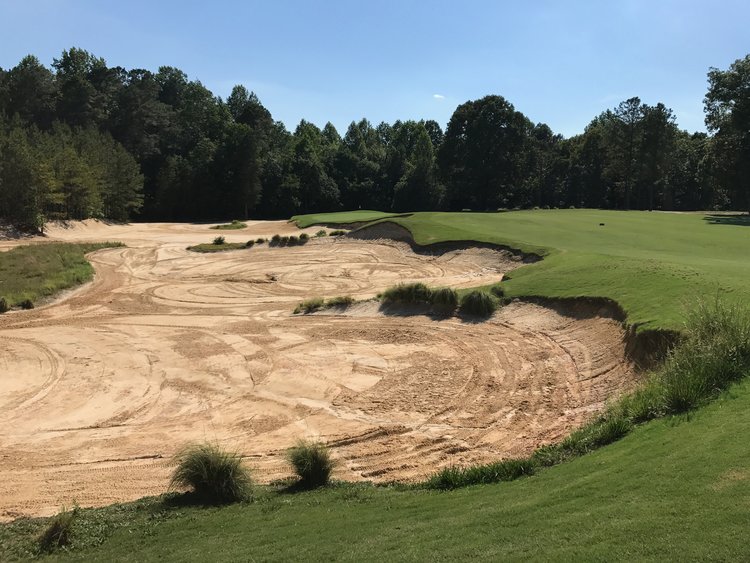Architect’s Roundtable is back! Jeff Mingay, Jay Blasi and Rob Collins join to discuss influential modern designs, master plans, maintenance and subtle design features.
What modern design (not your own) has had the greatest influence on your career?
Jeff Mingay: Probably Blackhawk in Edmonton, Alberta. I learned a lot about golf course design and construction while, first, building then subsequently doing more work to continue to improve that course with Rod Whitman over the years. I still think about things that were done at Blackhawk when I’m faced with similar challenges on other properties, and those lessons I’ve learned from Rod.
Jay Blasi: Whistling Straits – I saw the course while in college and was in awe of the massive earthmoving. I thought the routing and the way that the holes were terraced so they felt “on the water” even if they were set back was brilliant. I hated hole 5 and didn’t love the details of the bunkers, greens or how it played but it ultimately Whistling Straits really opened my mind to what could be CREATED.
Rob Collins: Tobacco Road. Prior to seeing it, I was opposed to many of the self-imposed rules of design that are commonplace in the modern profession. Tobacco Road opened my mind to the extent to which those rules can be disregarded. Every time I play it, I am amazed at the self-confidence of the course and the man who created it. It is obvious that he knew that he was designing and building something that would be off-putting to a certain percentage of golfers, but at the same time, would resonate strongly with people who have the proper mindset about golf. That is a risk that most architects are simply not willing to take, and Strantz pulled it off with flying colors. I am reminded of my favorite golf architecture quote when I think about Tobacco Road. In defense of his wild 16th green at Sitwell Park, MacKenzie said, “It is only natural that players who have been spoon fed on insipid, flat uninteresting golf should view with a considerable amount of suspicion anything which is undoubtedly out of the ordinary.”
Another important lesson about Tobacco Road that is often overlooked is that underneath all of the dramatic features, there is a golf course that is well-grounded in the fundamentals of great architecture. It is easy to lose sight of this fact considering all of the drama & quirk, but the solid foundation is what ultimately makes it work so well.
-

Photo credit: Ian Gilley
-

Photo credit: Ian Gilley
-

Photo credit: Ian Gilley
What do you recommend with regards to approaching a master plan for a renovation? Is a master plan the best/only way to go?
Jeff Mingay: It depends on what the specific issues are, course to course. For example, when I was approached by the Derrick Club they wanted to do a bunker renovation. After taking a look at the course, there were bigger problems to deal with than the bunkers. The course really had every problem imaginable. The routing didn’t work well which created safety and playability issues. There were widespread drainage problems and tree issues. All of these problems could only be dealt with by a comprehensive master plan.
On the other hand, I was asked to visit a course recently that I found in really good shape both architecturally and agronomically. There is nothing wrong with the routing or the greens, the bunkers are 10 years old, but still in good shape and the Superintendent’s done an excellent job dealing with trees and improving drainage in recent years. I, frankly, told the committee that the club would be wasting its money paying an architect for a master plan. Instead, they need to retain a consulting architect and pay him to assist with issues as they arise. Every situation and every course is different, so there are different ways to approach master planning.
Jay Blasi: Planning is an extremely important part of any project. Proper planning will help ensure the team reaches consensus and allows a project to move forward. Proper planning can save time and money.
Because every course is different, every site is different and every client is different, a good solution needs to be project specific. But while the ultimate plan needs to be project specific, I do believe that there is value in a strong process.
For me, that process is:
1. Study – learn as much as possible about the site, history, people, etc
2. Goal Setting – work with the team to establish high level project goals (i.e. build best course possible or preserve heritage)
3. Brainstorm – come up with a range of ideas for review and discussion
4. Refine – work with the team to determine what works and what doesn’t for that facility
5. Approve – agree on a design vision to be implemented and then preserved
6. Plan – prepare timelines, plans, budgets, etc
7. Execute – implement the plan
Rob Collins: I think it depends on the course and the circumstances of the renovation. If the construction work is going to be carried out continuously from start to finish, a more traditional plan would be appropriate. However, if the work is going to be carried out in piecemeal fashion over a longer period of time, then a master plan is essential to implementing the cohesive vision of the architect. With a master plan in hand, a club and their Superintendent can work hand in hand with the architect to make sure that whatever changes to the course are made each year are in line with the vision for the finished product. In the absence of a master plan, clubs can get bogged down in making changes that are detrimental to the long term health and prosperity of the course.
To what extent should maintenance be a factor when designing a golf hole?
Jeff Mingay: I’ve learned the hard way from experience, that maintenance considerations are everything. It’s the golf course Superintendents who make golf architects look good. When our courses are well-maintained, especially with architecture in mind, our work shines. It’s really important for Superintendents and architects to work as a team during the design and construction phases of any project, whether it’s building a new course or renovating an existing layout, to ensure the course can be properly maintained.
Jay Blasi: Maintenance needs to be considered. A hole doesn’t work if it can’t be maintained. Every facility is unique and has different resources, a different climate and a different topography. Ideally, when the team is working on the design of the hole maintenance will be discussed. Those discussions should focus on the design intent and then the group should work together to find ways to achieve those goals. In some instances that may require unique maintenance practices or extra resources for that hole, in other instances that may mean adjusting the layout to accommodate maintenance. Good planning and a willing team are the key ingredients for success.
Rob Collins: Long term maintenance is obviously a high priority when designing a golf hole. I think it is important to know your client and understand what their capabilities are maintenance-wise so that the design and construction methods fit within their maintenance budget. However, I also know that there needs to be a give and take between an architect and a client when it comes to maintenance. In other words, maintenance cannot be the only consideration. Artistic & unique design features are essential to golf, and it is possible that these features can require additional attention and maintenance.
What’s your favorite subtle design feature?
Mingay: Using the predominant slope of a green surface to create strategy. The fourth hole at the Derrick Club is a good example. It’s a short par-4 where the right side is heavily bunkered off the tee. The left is wide open, fairway. But, the green surface tilts pretty hard from left-to-right. It looks like left is the safe play off the tee, but that’s the toughest side to come into the green. Especially when the pin’s left.

The 4th hole at Derrick Club
Jay Blasi: Short Grass. One of the things I love most about golf is that it can be an ideal blend of physical skill and mental agility. To me that occurs most often when the ground contours matter. I love playing the ball on the ground and navigating contours. In short grass, contours matter. Players are afforded the opportunity to play the ball low or high. They can play a shot with spin or without. They can use a putter or a sand wedge and any club in between. The possibilities are endless.
I believe that short grass (with firm/fast conditions) is perhaps the best way to provide players with a mental challenge/opportunity.
Rob Collins: My favorite subtle design feature is a knob or a roll at the entrance to a green. A perfect example is on the fifth green at Friar’s Head. It is a feature that always requires thought and precise shotmaking on the approach and it doesn’t cost anything extra to maintain! Also, because it is a contour, its complexion and challenge changes from day to day depending on the location of the flag and one’s angle of approach.

The fifth green at Friar's Head - Photo Credit: Jason Way


 by
by 
